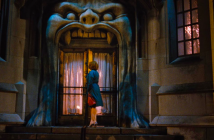
A Girl Walks Home Alone at Night (2014)
Cast: Sheila Vand, Arash Marandi, Marshall Manesh
Director: Ana Lily Amirpour
Country: USA
Genre: Horror | Romance | Thriller
Editor’s Notes: A Girl Walks Home Alone at Night opens in Toronto at TIFF Bell Lightbox tomorrow, January 23rd.
Self-dubbed as the first ever Iranian vampire film, debutant director Ana Lily Amirpour creates an empty, sullen landscape of sand, bodies, and darkness, placing interesting people down the street from each other before shaking the whole damn thing up. A Girl Walks Home Alone at Night strikes a beautiful balance between pulp, horror, romance, and drama which is truly astounding given a rather rudimentary plot and a first-time feature director. The first half of the film may gently glide from one character to the next, but Amirpour assuredly brings us to a controlled, focused conclusion that is certainly worth the wait.
The first half of the film may gently glide from one character to the next, but Amirpour assuredly brings us to a controlled, focused conclusion that is certainly worth the wait.
But the movie begins fixated clearly on Arash (Arash Marandi), who begins by playing the gallant, destitute stereotype which fortunately becomes complex as the plot rolls on. While caring for his junkie father (Marshall Manesh), Arash has his car and his pride taken by local drug lord Saeed (Dominic Rains) to pay off a debt. In pursuit of revenge (or at the very least, getting his keys back), Arash crosses paths with the eponymous Girl (Sheila Vand), the most disarming looking vampire this side of Iran, who piques the young man’s curiosity. Over some short period of time, the two tango back and forth with their feelings; the Girl weighing her emotions with her vampiric tendencies, and Arash being oblivious to what sort of romance he finds himself pursuing.
 What is immediately evident is the confidence behind the camera, thanks to the work of cinematographer Lyle Vincent and no doubt the product of a clear, particular vision on the part of Amirpour. Anytime a film is shot in black and white, the correct lighting (with regards to both accentuating the target mood and keeping the film optically stimulating) is absolutely essential, and the phenomenal style and conviction visually apparent throughout the film keeps this weird, spunky story on the rails. Particularly, Vincent is able to create tension and adrenaline several different ways. Early on when the Girl is about to take her first victim, the camera cuts back and forth, showing the terror head on, then cutting back as a form of respite before hurling the audience back into the action. This decision stands in stark contrast to an emotional climax when, after tripping on drugs at a club, meeting the Girl on a warmly shot street corner, and going back to her dwelling, the Girl plays a wonderfully appropriate song (“Death” by White Lies) over the speakers, subtextually calling out for Arash to join her. As he approaches the Girl from behind, perhaps going in for a kiss, oblivious to the Girl’s deadly capabilities, the camera holds longer and longer, capturing Arash’s slow, hesitant advance while allowing us to soak in the visual components of the scene (a disco ball is rapidly spinning to help accentuate the black-and-white surroundings) as well as the relevant musical accompaniment.
What is immediately evident is the confidence behind the camera, thanks to the work of cinematographer Lyle Vincent and no doubt the product of a clear, particular vision on the part of Amirpour. Anytime a film is shot in black and white, the correct lighting (with regards to both accentuating the target mood and keeping the film optically stimulating) is absolutely essential, and the phenomenal style and conviction visually apparent throughout the film keeps this weird, spunky story on the rails. Particularly, Vincent is able to create tension and adrenaline several different ways. Early on when the Girl is about to take her first victim, the camera cuts back and forth, showing the terror head on, then cutting back as a form of respite before hurling the audience back into the action. This decision stands in stark contrast to an emotional climax when, after tripping on drugs at a club, meeting the Girl on a warmly shot street corner, and going back to her dwelling, the Girl plays a wonderfully appropriate song (“Death” by White Lies) over the speakers, subtextually calling out for Arash to join her. As he approaches the Girl from behind, perhaps going in for a kiss, oblivious to the Girl’s deadly capabilities, the camera holds longer and longer, capturing Arash’s slow, hesitant advance while allowing us to soak in the visual components of the scene (a disco ball is rapidly spinning to help accentuate the black-and-white surroundings) as well as the relevant musical accompaniment.
… several musical tracks make important and discernibly weird contributions to an already-weird genre piece …
In fact, several musical tracks make important and discernibly weird contributions to an already-weird genre piece, sometimes serenading an audience from the speakers of Arash’s vintage car or simply enveloping the scene with an added sense of place. When the White Lies fills up the Girl’s room with their prominent drums and catchy lyrics, it successfully underlines the nature of the Girl’s relationship with her home, Bad City: equal parts animosity, fondness, and morbid curiosity. Like the Girl herself, Amirpour’s film has plenty of heart buried somewhere deep beneath the intentional layers of dark goofiness and mystery, and Arash is just the man to try and uncover it.
In fact, Marandi’s casting as Arash is particularly well suited for the part, not just because he can adequately wear an expression of both horror and obsessive curiosity so similarly, but also that Arash can be the familiar bedrock needed to help the film have a sense of uniformity despite pinging between at least three different genres. Jumping from a full-on horror thriller to an introspective junkie film, to even having gangster elements (the production design in Saeed’s pad is eerily reminiscent of Alfred Molina’s digs at the end of Boogie Nights), Arash is the grounding which makes A Girl Walks Home Alone at Night feel relatively cohesive, both in his temperament and the important role he plays as all the different plotlines converge at the end.
And in the end, Amirpour puts together a terrifically shot, bizarre take on vampires which doesn’t emphasize story so much as it focuses on the things which really highlight the strengths of the director: toying with tone, infusing interesting and relevant music, and composing interesting visual scenes. Overall, A Girl Walks Home Alone at Night has little to no frills, but at the same time has no problem extracting a terrifically moody and bizarre aura from a fairly regular story.
A Girl Walks Home Alone at Night strikes a beautiful balance between pulp, horror, romance, and drama which is truly astounding given a rather rudimentary plot and a first-time feature director.



